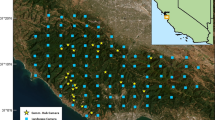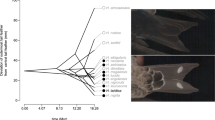Abstract
In species in which males and females exhibit different association patterns, the use of vocalizations that regulate interindividual distance may differ between the sexes. Spider monkey social groups are characterized by high fission–fusion dynamics and sex differences in association patterns; female–female associations have been described as more passive than those between philopatric males. Individuals of both sexes produce whinny vocalizations, which may allow callers and receivers to mediate interindividual spacing based on existing social relationships. As such, we hypothesized individuals of each sex would use whinny vocalizations at different rates and in different contexts. To investigate sex differences in the rate of whinnying across behavioral contexts, we collected focal animal samples on Yucatan spider monkeys (Ateles geoffroyi yucatanensis) over 8 mo at Runaway Creek Nature Reserve, Belize. In addition, we recorded all changes in subgroup composition to investigate whether a female’s likelihood of calling was influenced by the number of conspecifics joining, or leaving their subgroup. We found that females called at higher rates than males in most behavioral contexts, especially foraging. The probability that females would call increased during subgroup fissions and fusions, and correlated positively with the number of individuals joining or leaving their subgroup. Male calling rates did not differ across contexts, and males generally called less than females. Our results suggest that whinnying by females may allow callers to mediate interindividual spacing in contexts where proximity risks increasing feeding competition. In species in which the sexes associate in qualitatively different ways, vocalizations may play a role in maintaining these differences.




Similar content being viewed by others
References
Altmann, J. (1974). Observational study of behavior: Sampling methods. Behaviour, 49(3), 227–267.
Alvarez, S., Di Fiore, A., Champion, J., Pavelka, M. S., Páez, J., & Link, A. (2014). Male-directed infanticide in spider monkeys (Ateles spp.). Primates, 1–9. doi:10.1007/s10329-014-0454-y.
Arnedo, L. F., Mendes, F. D. C., & Strier, K. M. (2010). Sex differences in vocal patterns in the northern muriqui (Brachyteles hypoxanthus). American Journal of Primatology, 72, 122–128.
Asensio, N., Korstjens, A. H., & Aureli, F. (2009). Fissioning minimizes ranging costs in spider monkeys: A multiple-level approach. Behavioral Ecology and Sociobiology, 63(5), 649–659.
Asensio, N., Korstjens, A. H., Schaffner, C. M., & Aureli, F. (2008). Intragroup aggression, fission-fusion dynamics and feeding competition in spider monkeys. Behaviour, 145, 983–1001.
Aureli, F., & Schaffner, C. M. (2007). Aggression and conflict management at fusion in spider monkeys. Biology Letters, 3, 147–149.
Aureli, F., & Schaffner, C. M. (2008). Social interactions, social relationships and the social system of spider monkeys. In C. J. Campbell (Ed.), Spider monkeys: Behavior, ecology and evolution of the genus Ateles (pp. 236–265). New York: Cambridge University Press.
Aureli, F., Schaffner, C., Boesch, C., Bearder, S. K., Call, J., Chapman, C. A., Connor, R., DiFiore, A., Dunbar, R. I. M., Henzi, P. S., Holekamp, K., Korstjens, A. H., Layton, R., Lee, P., Lehmann, J., Manson, J. H., Ramos-Fernandez, G., Strier, K. B., & van Schaik, C. P. (2008). Fission–fusion dynamics: New research frameworks. Current Anthropology, 49, 627–654.
Boinski, S., & Campbell, A. F. (1996). The huh vocalization of white-faced capuchins: A spacing call disguised as a food call? Ethology, 102, 826–840.
Campbell, C. J. (2003). Female-directed aggression in free-ranging Ateles geoffroyi. International Journal of Primatology, 24(2), 223–237.
Carpenter, C. R. (1935). Behavior of red spider monkey in Panama. Journal of Mammalogy, 16, 171–180.
Chapman, C. (1990). Association patterns of spider monkeys: The influence of ecology and sex on social organization. Behavioral Ecology and Sociobiology, 26, 409–414.
Chapman, C. A., & Lefebvre, L. (1990). Manipulating foraging group size: Spider monkey food calls at fruiting trees. Animal Behavior, 39, 891–896.
Chapman, C. A., & Weary, D. M. (1990). Variability in spider monkeys' vocalizations may provide basis for individual recognition. American Journal of Primatology, 22(4), 279–284.
Chapman, C. A., Wrangham, R. W., & Chapman, L. C. (1995). Ecological constraints on group size: An analysis of spider monkey and chimpanzee subgroups. Behavioral Ecology and Sociobiology, 36, 59–70.
Cheney, D. L., & Seyfarth, R. M. (1996). Function and intention in the calls of nonhuman primates. Proceedings of the British Academy, 88, 59–76.
Clark, A. P. (1993). Rank differences in production of vocalizations by wild chimpanzees as a function of social context. American Journal of Primatology, 31, 159–179.
Eisenberg, J. F. (1976). Communication mechanisms and social integration in the black spider monkey, Ateles fusciceps robustus, and related species. Smithsonian Contributions to Zoology., 213, 1–108.
Fedigan, L. M., & Baxter, M. J. (1984). Sex differences and social organization in free-ranging spider monkeys (Ateles geoffroyi). Primates, 25, 279–294.
Ghisletta, P., & Spini, D. (2004). An introduction to generalized estimating equations and an application to assess selectivity effects in a longitudinal study on very old individuals. Journal of Educational and Behavioral Statistics, 29(4), 421–437.
Gros-Louis, J. (2004). The function of food-associated calls in white-faced capuchin monkeys, Cebus capucinus, from the perspective of the signaller. Animal Behaviour, 67, 431–440.
Hartwell, K. S., Notman, H., Bonenfant, C., & Pavelka, M. S. (2014). Assessing the occurrence of sexual segregation in spider monkeys (Ateles geoffroyi yucatanensis), its mechanisms and function. International Journal of Primatology, 35(2), 425–444.
Kondo, N., & Watanabe, S. (2009). Contact calls: Information and social function. Japanese Psychological Research, 3, 197–208.
Link, A., & Di Fiore, A. (2006). Seed dispersal by spider monkeys and its importance in the maintenance of neotropical rain-forest diversity. Journal of Tropical Ecology, 22(3), 235–246.
Link, A., Di Fiore, A., & Spehar, S. N. (2009). Female directed aggression and social control in spider monkeys. In M. N. Muller & R. W. Wrangham (Eds.), Sexual coercion in primates and humans: An evolutionary perspective on male aggression against females (pp. 157–187). Cambridge, MA: Harvard University Press.
Marler, P., & Tenaza, R. (1977). Signaling behavior of apes with special reference to vocalization. In T. A. Sebeok (Ed.), How animals communicate (pp. 965–1033). Bloomington: Indiana University Press.
Meerman, J. C. (1999). Rapid ecological assessment of Runaway Creek. Belize: Zoological Society of Milwaukee.
Mitani, J. C., & Nishida, T. (1993). Contexts and social correlates of long-distance calling by male chimpanzees. Animal Behavior, 45, 735–746.
Nishimura, A., Fonseca, G. D., Mittermeier, R. A., Young, A. L., Strier, K. B., & Valle, C. M. C. (1988). The muriqui, genus Brachyteles. Ecology and Behavior of Neotropical Primates, 2, 577–610.
Notman, H., & Rendall, D. (2005). Contextual variation in chimpanzee pant hoots and its implications for referential communication. Animal Behaviour, 70, 177–190.
Poole, J. H. (1994). Sex differences in the behaviour of African elephants. In R. V. Short & E. Balaban (Eds.), The differences between the sexes (pp. 331–346). Cambridge, U.K.: Cambridge University Press.
Ramos-Fernandez, G. (2005). Vocal communication in a fission-fusion society: Do spider monkeys stay in touch with close associates? International Journal of Primatology, 26, 1077–1092.
Ramos-Fernandez, G. (2008). Communication in spider monkeys: The function and mechanisms underlying the use of the whinny. In C. J. Campbell (Ed.), Spider monkeys: Behavior, ecology, and evolution of the genus Ateles (pp. 221–235). New York: Cambridge University Press.
Ramos-Fernandez, G., Boyer, D., Aureli, F., & Vick, L. G. (2009). Association networks in spider monkeys (Ateles geoffroyi). BehavioralEcology and Sociobiology, 63(7), 999–1013.
Rebecchini, L., Schaffner, C. M., & Aureli, F. (2011). Risk is a component of social relationships in spider monkeys. Ethology, 117(8), 691–699.
Rendall, D., & Owren, M. J. (2002). Animal vocal communication: Say what? In M. Bekoff, C. Allen, & G. Burghardt (Eds.), The cognitive animal (pp. 307–313). Cambridge, MA: MIT Press.
Santorelli, C. J., Aureli, F., Ramos-Fernández, G., & Schaffner, C. M. (2013). Individual variation of whinnies reflects differences in membership between spider monkey (Ateles geoffroyi) communities. International Journal of Primatology, 34(6), 1172–1189.
Shimooka, Y. (2003). Seasonal variation in association patterns of wild spider monkeys (Ateles belzebuth belzebuth) at La Macarena, Colombia. Primates, 44(2), 83–90.
Slater, K. Y., Schaffner, C. M., & Aureli, F. (2008). Female-directed male aggression in wild Ateles geoffroyi yucatanensis. International Journal of Primatology, 29(6), 1657–1669.
Slater, K. Y., Schaffner, C. M., & Aureli, F. (2009). Sex differences in the social behavior of wild spider monkeys (Ateles geoffroyi yucatanensis). American Journal of Primatology, 71(1), 21–29.
Sterck, E. H., Watts, D. P., & van Schaik, C. P. (1997). The evolution of female social relationships in nonhuman primates. Behavioral Ecology and Sociobiology, 41(5), 291–309.
Symington, M. M. (1987). Sex ratio and maternal rank in wild spider monkeys: When daughters disperse. Behavioral Ecology and Sociobiology, 20(6), 421–425.
Symington, M. M. (1988). Food competition and foraging party size in the black spider monkey (Ateles paniscus chamek). Behaviour, 105, 117–134.
Symington, M. M. (1990). Fission-fusion social organization in Ateles and Pan. International Journal of Primatology, 11, 47–61.
Teixidor, P., & Byrne, R. W. (1999). The ‘whinny’ of spider monkeys: Individual recognition before situational meaning. Behaviour, 136, 279–308.
Trivers, R. L. (1972). Parental investment and sexual selection. In B. Campbell (Ed.), Sexual selection and the descent of man (pp. 1871–1971). Chicago: Aldine.
Wallace, R. (2006). Seasonal variations in black-faced spider monkey (Ateles chamek) habitat use and ranging behaviour in a southern Amazonian tropical forest. American Journal of Primatology, 68, 313–332.
Wrangham, R. W. (1987). Evolution of social structure. In B. B. Smuts, D. L. Cheney, R. M. Seyfart, R. W. Wrangham, & T. T. Struhsaker (Eds.), Primate societies (pp. 282–297). Chicago: University of Chicago Press.
Acknowledgments
This research was supported financially by the Natural Sciences and Engineering Research Council of Canada. Special thanks go to Gil and Lillian Boese from the Zoological Society of Milwaukee and the Foundation for Wildlife Conservation for permission to work at RCNR. Thanks to Birds without Borders for their assistance and support throughout this project. Thanks go out to the staff at the Tropical Education Center, Belize, for accommodation. This research would not have been possible without the many hours of field support and assistance in data collection by Gilroy Welch; thank you so much for your hard work and patience in the field. We would like to acknowledge Gabriel Ramos-Fernandez and an anonymous reviewer, as well as the editor-in-chief, Joanna Setchell, for their helpful feedback and suggestions on early drafts of this article. We also thank Tak Fung for his technical expertise and support with our statistical analysis. To Peter Henzi, many thanks for your helpful comments on earlier drafts of this article.
Author information
Authors and Affiliations
Corresponding author
Rights and permissions
About this article
Cite this article
Dubreuil, C., Notman, H. & Pavelka, M.S.M. Sex Differences in the Use of Whinny Vocalizations in Spider Monkeys (Ateles geoffroyi). Int J Primatol 36, 412–428 (2015). https://doi.org/10.1007/s10764-015-9832-6
Received:
Accepted:
Published:
Issue Date:
DOI: https://doi.org/10.1007/s10764-015-9832-6




